On the formation of planets
This is where I will learn you something about how planetary systems, like ours, are formed in space. I won't take it up to a very high level. If you want to know more just send me an e-mail.

 Back to home.
Back to home.
The early explanation of the existence of our solar system; Laplace, roche and Jeans.
There has alwa
ys been the question why we exist. A related question is why our solar system exists. A more scientifically important question is how our solar system was formed.
One of the earliest "modern" ideas was that a big cloud of gas and dust started to collapse under it's own gravity. Due to intensive research by Roche and Laplace, famous mathematicians from the era of "enlightement" a new sciense was invented, so called "cosmogenism". This branch of (astro-)physics tries to explain the start (the "genus", "genism" part) of our solar system, or space as a whole (the "cosmo" part).
I will try to explain some of the ideas of these cosmogenists and I will give you an introduction to the more modern ideas about the formation of our solar system.
The principles of collapsing gas-clouds.
Imagine a cloud of gas, a vast and very cold cloud, somewhere between 10 and 100 K. Even though the cloud is very cold, the particles still move around and collide with each other. Therefore there is a certain gas-pressure.
On the other hand, the force of gravity is trying to pull all the gas-particles (and dust particles the same) towards the center of gravity. Will a cloud fall towards this point or will it expand because of the pressure forces?
A famous astronomer of the twentieth century, Sir James Jeans derived a law for a cloud of hydrogen with a certain potential energy and a kinetic pressure. It states that the cloud will expand when it has a radius bigger than a certain radius, called the "Jeans-radius", of course, and collapse when it's radius is smaller than this radius.
Normally a cloud will be in the neighbourhood of the equilibrium position, i.e. where the pressure forces, trying to expand the cloud, and the force of gravity, trying to contract the cloud, are the same.
So, if we want the cloud to form a star and a planetary system, we need something to push it over the edge, so to speak. An obvious choice would be a supernova nearby.
For a detailed derivation of this law click here.
The cloud as an ice-skater.
We pushed our poor cloud over the edge and it will start to collapse (we hope). What will happen? Well, since everything in space rotates, so will our cloud. As the cloud collapses inward, it sort of retracts it's arms and, just like an ice-skater retracting his arms doing pirouettes, it starts rotating faster and faster.
If you want to know exactly how it works. And we DO want to know anything, right?
Because of this it gets thinner at the poles and wider in the plane of the equator. (it sort of flattens)
So, now we've got a spinning pancake, a bit thicker in the middle. We want some planets to form...but don't know how. Unfortunately, the real scientists aren't sure either. But there are some very cool ideas about how planets were able to form from the pancake of dust. So from here it really starts to get interesting! (so wake up if you've fallen to sleep!)
Planet forming Mechanisms
One of the most important clues about how our solar system was formed, comes, strangely enough, from meteorites which fell on earth. Inside some of those meterorites, called "Chondrites" small droplets of ancient material were found, called "Chondrules". These chondrules contain the primordial material of our pancake and can thus tell us a lot about the physical situation our pancake was in. It turned out that in order to explain the formation of our solar system, one had to answer three questions:
- Where to the chondrules come from?
- How were the chondrules melted and combined to form large particles?
- How were these conglomerates of chondrules mixed with the material in our pancake to collide and become real big clumps of dust and gas?
If you know the exact answer, please mail it to the address you can find above.
I will now discuss some of the proposed mechanisms to explain the three dilemma's. These mechanisms are generally refered to as "Chondrule-factories".
The Jet Mechanism.
One of the ideas consists of a machanism where the accretion-disk (our pancake) interacts with a jet at the inner edge of the disk. At this inner edge matter is trapped in magnetic fields, caused by the currents of charged particles orbiting around the early sun. This material is then catapulted away in a big jet. An example of such a jet around a young star can be seen in this image taken by the hubble space telescope.
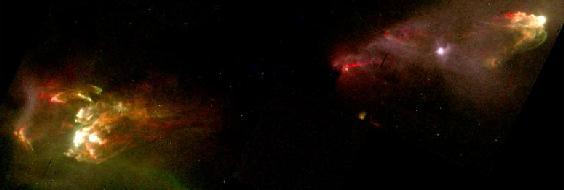
This image shows two bright areas, to the left and right of the picture. These two spots light up, since the material ejected from the young star collides with the interstellar material.
Somewhere in between our young star sits, hidden by the dark clouds of gas and dust he was born out of.
As you can see, the jet blows away in two opposite directions, and always perpendicular to the plane, parallel to the rotation axis.
Now as you might have guessed, the material in the jets inhibits quite a lot of energy. (they have enough of energy to light up the interstellar material, which is probably an atomic transition, with an energy of a couple of electronvolts) So we might use the jets to heat particles moving into these jets. There are two results. Firstly, when the particles move into the jets, they are pushed upwards. Secondly, they are propably broken into pieces, or maybe melted. Remember the questions posed on the system we try to create? We already answered one of them!
Imagine we've got some larger particles moving inward (which is possible because of gas-drag) until they reach the jet. There smaller droplets are ablated off of the larger objects. They move upwards in the jet and collide and melt into bigger particles. Because of the angular momentum the particles have, they will move out of the jet at some altitude and will hoover over the accretion disk. There, they will also feel some gas-drag and start to fall back to the accretion disk. They will mix with matter in the accretion disk. This answers the second and third question.
In a picture the system looks like this:
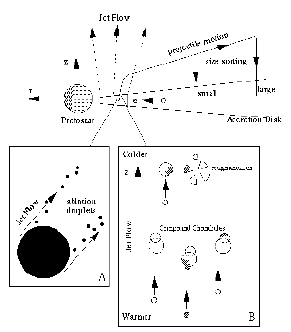
This is quite an extraordinary system answering many of the questions.
Lightning in a Dust Disk
Another way to melt metalic pieces together is to use electricity. In our disk a lot of gasparticles move around and collide with each other and with dust particles. Even though the kinetic energy of the disk may not be very big, there still might exist some induced excess charge. The electrons might be bumped out of there orbits and move to the nearest object at positive potential, normally larger particles. When this excess charge gets big enough, there might be such a big potential difference that one gets lightning. Just like in a neon tube the accelerated electrons collide with gas particles and ionize more and more of them, until a large current runs from the negative source to the object at positive potential. This however is not the same as with lightning in our atmosphere.
Lightning in our atmosphere is a current between two points, while the current discussed above is between to larger areas. Furthermore, in dust the electricity is more spherically distributed, like an aurora. So, the energy per area is not really big. So, we really need big, or very longlasting discharges to melt the particles together.
However, this system explains the question of mixing, since the melting takes place in the disk itself, so we don't need to mix it afterwards. It also explains another phenomenon. From research in meteorites it became clear that the melting proces must have been something periodical in time. Since the time between two consecutive discharges can be thought to be roughly equal as long as the reservoir of negative charge stays locally constant dispite of the discharges, this is also a periodical system.
The Gamma Ray Burst theorem
Another interesting idea is that a gamma ray burst took place at a certain distance where the energy arriving in our young solar system was thus that it melted the tiny particles into chondrules. However, this means that all the chondrules were formed at the same instant in time. (even though the energy would be arriving in a certain time interval, definitely not all in a millisecond or so) This way, the discharge is probably anisotropical, since most of the energy would be absorbed at one side of the disk, while the other side would receive far less energy. It does not explain the mixing, but it wasn't invented to do so anyway.
The most important implication however, is that the existence of planets becomes something very special, since GRB's are pretty rare!
A mixing theory.
Now I just discuss a mixing theory I once found as well as amuzing as appropiate. There is something called the "muesli-mechanism". Did you ever shake a box of muesli? One of the things you might have found (try it at home) is that the larger particles of the muesli start to appear as they plunge trough the surface, while the smaller particles don't really seem to be moving. (this however is not true) This is called the muesli effect. You will get this certain effect when you shake the box vertically. When shaking the box horizontally however, the larger particles on top descent and larger particles come up at the side, near the walls of the box.
This mechanism was mathematically described by Kurt Liffman and I'm going to show you how it works. In the end, I'll give you the relevance of it in the area of planet formation.
Imagine we have a big box filled with particles we imagine to be attached like springs, with a spring constant k. They are allowed to penetrate each other and we call the depth of penetration delta r. The c is a damping constant, which means that the particles won't oscillate for ever, but are influenced by a friciton. The net force is force of gravity.

Shaking the box horizontally;

we get the following picture of the flow of particles inside the box.
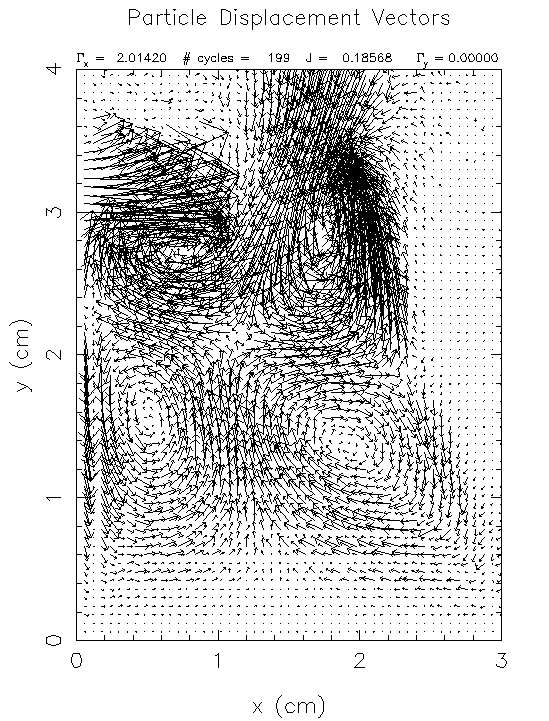
You might think this is not very relevant to the case if planet-formation, but I was thinking, let's assume that there is an area of lower density surrounded on both sides by an area of much higher density. You might look at those two dense areas as the sidewalls of your muesli-box. Now, you remember the jet at the innerside of our disk? There is a lot of interaction at that place and I think it might be possible that there are a lot of shocks or maybe even sound waves running through the disk, because of this violent interaction. If this is the case, it might be so that heavier particles are automatically mixed, just like your muesli.
Dust, dust and more dust...
Another important topic is the presence of dust in our disk. Even though 99% of the cloud consists of gases and only 1% of dust-particles they have three important roles in the formation of a planetary system from our original dust-disk.
The first thing it does is dissipating energy away, mainly in the infrared region. When we assume that a supernova disrupted our molecular cloud, we must realise that the compression by the shock waves heats up the gas. Without a proces which gets rid of the heat no collapse will ever take place. Already in this stage the mere 1% of the mass of the cloud, with a density of about 10E-22 grams per cubic centimetre, makes sure that chores are able to be compressed without heating.
The further role of dust in our cloud depends on the specific density of the dust and thus depending on the time after the initiation of the collapse.
During the collapse of the cloud the heat resulting from the dissipative forces are radiated away from those regions where the density is small enough. This way, the chore won't bounce and expand again.
When the density has become bigger than 10E-13 grams per cubic centimetre, the cloud becomes optically thick for the radiation and the chore starts heating up. This way the heating up of our young star starts until the temperature and the pressure has become that high that nuclear fusion starts.
Finally, the dust in the disk regulates the opacity and therefore the ability to radiate heat away or not. Thus, the local density of dust regulates the local temperature of the disks and therefore the speed at which planets are able to form.
This picture shows a model of the gas density (bold lines) and the velocity-vectors.(arrows)
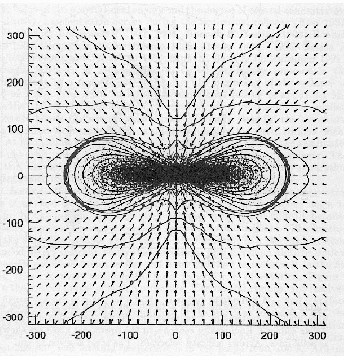
Here are some Hubble pics of dust disks around stars in the orion nebula.
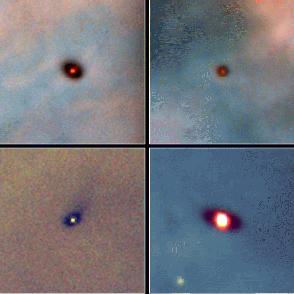
Do you see the similarity? Look at the simulated image. At the poles, the density is much smaller than the density at the equator. So, if we want to see the early star, we need to be in the happy position where we look directly at the poles. In the Hubble picture we see the stars shining through the dust. However, most pictures are in false colours and it might also be that the stars we are looking at are already in a later stadium of formation as the cloud shown in the simulation. ALWAYS BE AWARE OF THE USE OF FALSE COLOURS WHEN LOOKING AT ASTRONOMICAL PHOTO'S LIKE HUBBLE PICTURES!!
Now, we know quite a lot. We know how the molecular cloud starts to collapse.
Why it starts to rotate faster and faster, why it flattens. Why it heats up, or why it doesn't, how the young star starts to heat up and how chondrules are formed, which turn into planetesimals.
The first planets to show up, now scientists believe, are gas giants and therefore it is interesting to have a look at the models for the formation of gas-giants.
The Formation of Gas-Giants
We know believe that the gas-planets were the first to form in our solar system. Why? I can give you two arguments. The first are the asteroids between Jupiter and Mars. They are probably the remains of a try to form a solid planet which was interrupted by the gravitational forces of Jupiter, which must have been complete.
Another argument is that the temperature in the inner regions were much higher than at the outer regions and also the early sun must have played a lot with al the matter in the inner regions. Therefore, the density of gas must have been a lot higher at a distances where Jupiter formed. Another important thing is that a low temperature is needed for water ice to form. And water ice is one of the katalists for the accumulation of dust particles.
In fact there are two different groups of gas giants in our solar system. We have Jupiter and Saturn on one side, consisting most of gases like helium and hydrogen and on the other side we have Uranus and Neptune, consisting most of Ices, mainly ammonia-ice.
I will concentrate on the formation of Jupiter, which was, together with Saturn, was formed first. This because the density of planetesimals was much lower at the distances where Uranus and Neptune were formed.
Jupiter
In the most recent model I've read Jupiter was formed in a turbulent accretion disk. The turbulence and different scaling heights regulated the pressure and temperature at different distances from the early sun. The parameters of the model were changed until they produced the right temperature and pressure throughout the accretion disk. (in fact the RIGHT temperature and pressure were found by fitting the found enrichement in deuterium throughout the solar system to the observed present enrichement in deuterium, but I'm not going to discuss that here...) By using the found temperature and pressure at the distance where Jupiter was formed, a good estimation of the time it took to form Jupiter could be made.There is one important topic however we need to cover in order to understand the usefulness of the new model.
Clathrate Ice
An Astro-chemist who was part of the team, took a good look at the pressures and temperatures and claimed that he could find a solution to a problem found by a very special space-probe; the Galileo-probe.
This probe entered the Jovian atmosphere in the mid-nineties and measured a lot of quantities among which the abundances of heavy elements with respect to the abundances found in the sun. It turned out that they were much higher than could be explained by the early models. This is where the astro-chemist came in.
In the proces three phases are assumed.
-In the first phase dust particles and ice collide and accrete until after about 10^6 to 10^7 years a core of 10 earth masses is formed.
-In the second phase, planetesimals accrete from a feeding zone around the core, while little gas accretes. The core grows and grows until a critical mass is reached after about 10^5 yrs.
-When the core has reached a mass equal to the so called 'gaseous envelope' which is a part of the feeding-zone close around the core, containing a lot of gas, this envelope collapses unto the core in a very short period of time, only about 10^3 yrs.
In the first phase nothing new happens which wasn't already assumed. (Very recently however, it was shown in zero gravity experiments during shuttle flight s or in spce probes, that dust particles do not form little blobs of dust as was assumed, but rather linear strains like molecular polymeres. It is yet unknown what this means in the formation of planets.) Except for one very important thing. In old models water formed ice-crystals which floated around the young core or collided and accreted unto the core.
Normal water consist of very large crystals having six sides and forming long, diamond like shapes. This ice is generally refered to as 'amorphous ice' since the ice is not as perfect as most pictures want to make you believe, but contains many irregularities and open ends. The important thing is that amorphous ice is very inefficient in enclosing small gass molecules. Even though it does happen, it doesn't happen a lot.
The astro-chemist showed that under the circumstances found by the model, another form of ice could be formed so called 'clathrate ice crystals' an example of which is shown below.
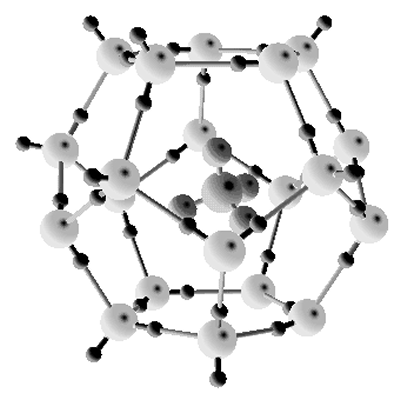
See the outer ball-like shape? That are the water molecules forming a kind of "buckyball". This term generally refers to a ball of carbon-atoms which form a big carbon ball also with a cavity in the center. (a carbon buckyball normally constists of some 60 carbon atoms. REALIZE THAT A CARBON BUCKY-BALL IS AN ATOMIC CRYSTAL AND NOT A MOLECULAR ONE AS IN THE CASE OF WATER ICE OR CLATHRATE WATER ICE!!)
In the center you can see a methane molecule trapped. And that's the whole point! This form of water ice IS very efficient in trapping gasses and therefore heavy elements. Think what happens if we release all the trapped gasses in the Jovian atmosphere! And that's exactly what happens later on!
Now, in the second phase only planetesimals and bigger rocks accrete on the core, but no gas at all and also not the very small and light clathrates, containing all the heavy elements we were looking for. However, the clathrates are on the other hand too heavy to behave like gases. Physically we say that the clathrates are decoupled from the gas. The tiny crystals won't behave like gas, but they won't accrete on the core also. What's left is that they will follow orbits around the core, or maybe float in big orbitals around the sun.
The gas however will move out of the feeding zone, because of the temperature difference between the inner-side of the solar system and the outer side. So in comparison with the early sun, the ratio of heavy elements with respect to the other gasses is bigger at the spot of Jupiter than in the sun. That explains the higher abundances the Galileo probe measured, if we assume the trapped heavy elements were released into the atmosphere at some point.
Here are the measured abundances together with the calculated one. Notice that all abundances are larger than solar. Also notice that some calculated values still seem to be incorrect. In the case of Carbon this is due to the fact that carbon could also have been in the form of larger carbonhydrate molecules (very small fats or alcohol, organic in whatever form) which weren't accounted for in the model. Also the question whethter most carbons were trapped in the form of carbon-monoxide or methane might influence the values. The same story goes for sulfur. Oxygen however might have been in lower layers of the atmosphere, which the probe only reached in many, yet very small pieces, if you get what I mean. Therefore future missions to Jupiter should try to examine the right amount of oxygen in the atmosphere, in order to check the model used here.
So we now know that Jupiter was formed in three phases. That the heavy elements were trapped in a kind of bucky-ball water ice and that it was completed somewhere between 1.3 and 2.1 Million years after the core started to form.
I hereby tell you that the formation of Saturn was likewise, but it just took a longer time.
The other planets
Uranus and Neptune must have formed more with the principle of accretion of dust and ice, since a lot of gas was consumed by the above mentioned giants. This is no problem, since most of the atmosphere of Uranus and Neptune consist of ice. (not water, yet different molecules which are on themselves very different from the moleucles found in Jupiter and Saturn.) Therefore the formation of both must have started later and must certainly have taken a much longer time.
Pluto is probably just a lost chunk from the so called oort-cloud. This is a ring of large ice-clumps where also the comets originally came from. So, I wouldn't call Pluto a planet, since it must have been there all the time, part from the coagulation of dust and a lot of ice to form it.
The conditions in the inner part were much different. Most of the gas moved outwards, due to a blowing inferno and high temperatures. Because of these circumstances only the bigger planetesimals survived and therefore the inner-planets must have taken a very long time to form, probably through collision of planetesimals in the inner regions together with collision of planetesimals coming from the outer regions, maybe even pulled in by Jupiter.
There was virtually no gas and therefore the atmospheres of the inner-planets (as far as they are present) must have come form the release of gasses due to vulcanisms, and the release of water when comets struck the inner-planets. (Just look at the moon and you'll understand the chaos the early solar system must have been in, with hoovering pieces of rock, dust and ice everywhere!)
Even the existence of our moon is probably the results of such an accident.
HUH? Okay, here it comes. Do you see the moon ever changing, apart from the fact that it grows from new moon, to full moon and back again? I guess not. That's because she always has the same side turned to the earth. It's just as if she was still connected to the earth with an invisible line. The trick is that the change we would see because of the rotation around her own axis is the same as the change we would see simply because of the rotation of the moon around the earth! Try this at home, (or in your mind) with two apples or something and see what you would have to do in order to keep the same side of the "moon-apple" pointed to the "earth-apple".
Remembering the angular momentum, it's not hard to convince yourself that there is something about the angular momentum of the moon and the earth which ties them together. Therefore the earth and the moon were probably once part of the same object. So, we might just as well have lived on a much bigger planet, maybe with a different atmosphere and without a moon. What do you prefer? (Can you now give a simple argument why the outer planets have so many more moons than the inner ones?)
I will conclude this journey through the history of our solar system with one remark. Even though we explained a lot, there are still many questions left. I will give you one final mystery to think about. If the inner planets were all formed through the collision of various random planetesimals, comets and whatever was floating in the solar-system space, why are the compositions of the inner planets all so very different from each other?
I hope you enjoyed this tour and I hope you learned something and that you've become interested. There are more topics I discuss. They are however somewhat more theoretical and stranger than this one has been. But, you've learned a lot and you will be able to grasp a lot more. For the interested reader: There will be a literature index in the near future, located on the main-page.
 Back to home.
Back to home.
 Back to home.
Back to home.







